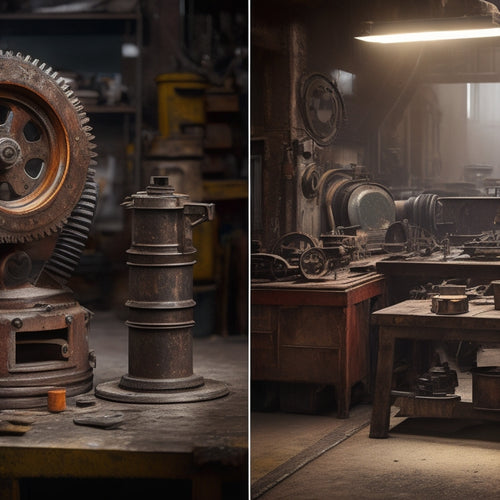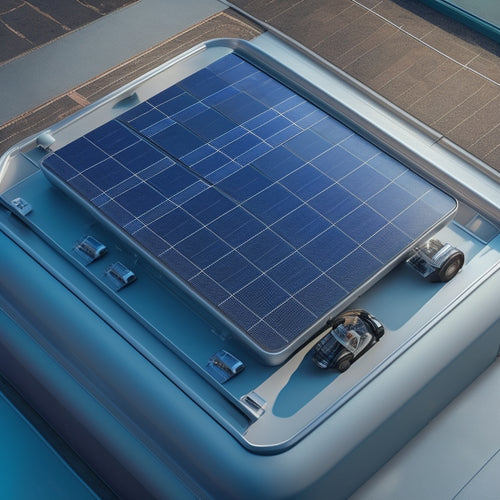
Understanding the 7 Elements of Average Residential Solar Installation Cost
Share
When you're planning a residential solar installation, you'll encounter seven key factors that affect the overall cost. These include system size and quality, installation company and labor, roof size and complexity, local building codes and permits, energy efficiency and incentives, battery backup and storage, and monitoring and maintenance costs. Each element plays an essential role in determining the final expense of your solar installation. As you investigate these factors, you'll gain a better understanding of how they impact your investment and can optimize your system for maximum energy savings and return on investment.
Key Takeaways
- System size and quality, including panel type and material quality, directly impact overall cost and energy savings.
- Installation company reputation, labor skill levels, and warranties affect cost, quality, and maintenance requirements.
- Roof size, complexity, and orientation influence installation difficulty, panel placement, and energy output.
- Local building codes, permits, and inspection requirements add to costs and ensure compliance with safety regulations.
- Energy efficiency, incentives, and battery backup options can enhance energy savings, reduce costs, and provide reliability during outages.
System Size and Quality
Since you're considering investing in a solar panel system, understanding how system size and quality impact the overall cost is essential.
The size of your system, measured in watts (W), directly affects the cost. A larger system requires more solar panels, increasing the cost. However, a larger system also generates more electricity, leading to higher savings on your utility bills.
The quality of your solar panel system also plays a significant role in determining the cost. You'll need to decide between different solar panel types, such as monocrystalline, polycrystalline, or thin-film panels. High-efficiency panels may be more expensive, but they'll generate more electricity per hour of sunlight.
Additionally, the quality of installation materials, such as inverters, mounting hardware, and wiring, will impact the overall cost. High-quality materials may be more expensive upfront, but they'll last longer and require less maintenance.
Installation Company and Labor
Typically, homeowners underestimate the significance of choosing the right installation company and labor when it comes to the overall cost of their solar panel system. You may think that all installation companies are created equal, but that's far from the truth. The installation company's reputation and labor skill level can greatly impact the final cost of your solar panel system.
| Installation Company/Labor Characteristic | Impact on Cost |
|---|---|
| Installation company reputation | Higher reputation = higher cost (but also higher quality) |
| Labor skill level | Higher skill level = higher cost (but also higher efficiency) |
| Certification and training | Certified and trained labor = higher cost (but also higher quality) |
| Warranty and maintenance | Detailed warranty and maintenance = higher cost (but also higher peace of mind) |
| Local permits and compliance | Company's experience with local permits and compliance = higher cost (but also higher assurance of meeting regulations) |
When choosing an installation company, consider their reputation, labor skill level, certification, and warranty. While a higher cost may seem intimidating, it can lead to a higher-quality installation that will save you money in the long run.
Roof Size and Complexity
Across your roof's surface, solar panels will soon be installed, but have you considered how the roof's size and complexity will impact the overall cost of your solar panel system?
The size of your roof plays a significant role in determining the number of solar panels needed, which in turn affects the cost. A larger roof requires more panels, increasing the cost.
Roof complexity, on the other hand, refers to the roof's design, material type, and orientation. A roof with a steep pitch, multiple skylights, or complex angles can make installation more challenging, adding to the cost.
A thorough shading analysis is essential to identify areas with partial shading, which can affect solar panel placement and overall system performance.
The orientation of your roof also impacts the system's energy output, with south-facing roofs being the most favorable.
Installation access is another vital factor, as difficult-to-reach areas may require additional equipment and labor, increasing the cost.
In addition, the structural integrity of your roof must be assessed to guarantee it can support the weight of the solar panels.
All these factors will be taken into account when determining the best solar panel placement and system design for your home.
Local Building Codes and Permits
When you're planning to install a solar panel system, you'll need to maneuver through the permit application process, which can vary depending on your location.
You'll need to guarantee that your installation complies with local building codes, which cover aspects like electrical and fire safety.
Additionally, you'll need to schedule inspections and obtain approval from local authorities before you can start generating electricity.
Permit Application Process
You're about to commence the permit application process, a crucial step in guaranteeing your solar installation meets local building codes and regulations. This process involves submitting your project plans and specifications to your local government for review and approval.
There are various permit types required for a residential solar installation, including electrical, building, and zoning permits. The application timeline typically ranges from a few weeks to several months, depending on the complexity of your project and the workload of your local permitting authority.
You'll need to provide detailed documentation, including system designs, electrical schematics, and structural calculations, to demonstrate compliance with local building codes and regulations.
Your solar installer may handle the permit application process on your behalf, but it's vital to stay informed and involved throughout the process. Be prepared to address any comments or concerns raised by the permitting authority, and factor in the associated costs and timelines into your overall project budget and schedule.
Building Code Compliance
Your solar installer submits the permit application, and now it's time to confirm your system complies with local building codes and regulations. This involves verifying your solar panel system meets the necessary safety regulations, energy standards, and inspection standards.
Your installer will need to maneuver through local ordinances, zoning laws, and building permits to confirm compliance. Code updates can sometimes create compliance challenges, but a reputable installer will stay up-to-date on the latest regulations.
They'll make certain your system is designed and installed to meet or exceed local requirements. This includes adhering to specific guidelines for rooftop installations, electrical connections, and structural integrity.
Compliance is vital to avoid costly rework, guarantee a safe installation, and confirm your system operates efficiently. Your installer will handle the necessary paperwork and coordination with local authorities to obtain the required building permits.
Inspection and Approval Requirements
Local building codes and permits require a series of inspections and approvals before your solar panel system can be deemed operational. This approval process involves multiple stakeholders, including local authorities, electrical inspectors, and building officials.
You'll need to guarantee regulatory compliance by meeting the necessary standards and codes.
The inspection costs will depend on the complexity of your installation and the frequency of inspections required. Typically, you can expect a solar inspection to occur after the installation is complete. The inspector will review your system against an inspection checklist to verify it meets the necessary standards.
The approval authorities will review the inspection report and issue final approval once your system meets all the requirements. This process can impact your installation timeline, so it's crucial to plan accordingly.
You should factor in the time and costs associated with the approval process to avoid delays and unexpected expenses. By understanding the inspection and approval requirements, you can guarantee a smooth and successful solar panel installation.
Energy Efficiency and Incentives
Solar panels are becoming increasingly energy efficient, allowing homeowners to generate more electricity from the same amount of sunlight.
As you consider installing solar panels, you'll want to investigate energy conservation strategies to maximize your energy savings. Start by conducting an energy efficiency audit to identify areas for improvement in your home. This will help you prioritize home upgrades, such as installing smart home technology, to reduce your energy consumption habits.
You may also be eligible for utility rebates and solar tax credits, which can greatly reduce your upfront costs. Additionally, you can examine financing options and renewable energy certificates to offset your investment.
Battery Backup and Storage
Many homeowners who invest in solar panels also contemplate pairing them with a battery backup and storage system. This addition can provide you with a reliable source of energy during power outages and grid failures.
When choosing a battery backup and storage system, you'll want to contemplate the different solar battery types available. Lithium-ion batteries are a popular choice due to their high energy density and long lifespan. Other options include lead-acid batteries and flow batteries, each with their own advantages and disadvantages.
When selecting an energy storage solution, you'll need to contemplate your specific energy needs and goals. Do you want to power your entire home during an outage, or just essential appliances like refrigerators and medical equipment?
The size and type of battery you choose will depend on these factors, as well as your budget and available space. On average, a battery backup and storage system can add $5,000 to $15,000 to your overall solar installation cost.
However, this investment can provide you with peace of mind and energy independence during uncertain times.
Monitoring and Maintenance Costs
You'll need to evaluate the costs of monitoring and maintaining your solar installation to guarantee it's running at peak levels.
This includes system performance tracking, which provides real-time data on your system's energy output, and energy output verification, which confirms your system is producing the expected amount of energy.
These services typically come with a recurring fee, which can vary depending on the provider and frequency of monitoring.
System Performance Tracking
Your photovoltaic system's performance relies heavily on regular monitoring and maintenance to guarantee peak energy production. To ascertain your system operates at its best, you'll need to track its performance regularly.
System performance tracking involves monitoring your solar panel system's output and identifying areas for improvement. This is typically done through a monitoring system that provides real-time data on your system's performance.
You'll want to keep an eye on key solar performance metrics, such as energy production, capacity factor, and performance ratio. Data analysis tools can help you make sense of this data, identifying trends and anomalies that may indicate issues with your system.
Energy Output Verification
Energy output verification is a critical component of solar installation cost, as it assures your system is generating the expected amount of electricity. This process involves monitoring your system's performance metrics to ascertain it's producing the predicted energy output. As a homeowner, you want to be confident that your solar panels are performing at their best, and energy output verification provides that guarantee.
| Performance Metric | Description |
|---|---|
| Energy Yield | Measures the total amount of electricity generated by your solar panels |
| Capacity Factor | Calculates the percentage of your system's maximum potential output |
| Performance Ratio | Compares your system's actual energy output to its expected output |
| System Uptime | Tracks the percentage of time your system is operational |
| Energy Availability | Measures the percentage of time your system is available to generate electricity |
Frequently Asked Questions
Can I Install Solar Panels on a Metal Roof?
You can install solar panels on a metal roof, leveraging its advantages like durability and resistance to weathering, but be prepared to address installation challenges like ensuring watertight sealing and accommodating unique roof structures.
Do Solar Panels Work During a Power Outage?
You're wondering if solar panels work during a power outage. Unfortunately, they don't, as they're tied to the grid and shut off for safety reasons. However, you can consider power outage solutions like battery backup systems to guarantee continuous solar panel functionality.
Can I Sell Excess Energy Back to the Grid?
You can sell excess energy back to the grid through net metering benefits, energy buyback programs, and earning solar energy credits, but you'll need to meet grid connection requirements, ensuring a seamless exchange of power.
How Long Does a Solar Panel Installation Take?
Imagine a puzzle coming together; you're wondering how long it takes to complete. The installation timeline varies, but typically takes 3-5 days for a standard residential setup, depending on installation factors like roof size and complexity.
Do Solar Panels Increase My Property Value?
You'll be pleased to know that solar panels likely increase your property value, as they appeal to homebuyers seeking energy savings, environmental benefits, and installation incentives, which are reflected in a higher property appraisal, aligning with current market trends and homebuyer preferences.
Conclusion
You've made it to the final piece of the puzzle! Now that you've got a grasp on the 7 elements that influence the average residential solar installation cost, you're one step closer to utilizing the power of the sun. But, don't think you can just sit back and bask in the savings - there's still more to uncover. Stay ahead of the game by keeping an eye on developing incentives, emerging technologies, and shifting industry trends. The future of solar is bright, and you're just getting started!
Related Posts
-

Why Higher Upfront Costs Are Worth It
You pay a premium for high-quality, energy-efficient products, but they're worth it. With durability testing ensuring...
-

Top Solar Panels for Car Battery Maintenance
When selecting top solar panels for car battery maintenance, consider high-efficiency models with high wattage output...
-

Why Cities Need Smart Charging Infrastructure Now
You're about to experience a tidal wave of electric vehicles hitting your city's streets, and it's essential you're p...


